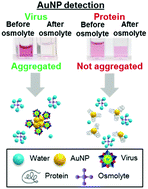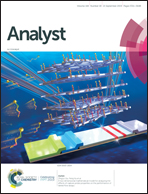Mannitol-induced gold nanoparticle aggregation for the ligand-free detection of viral particles†
Abstract
Traditional virus detection methods require ligands that bind to either viral capsid proteins or viral nucleic acids. Ligands are typically antibodies or oligonucleotides and they are expensive, have limited chemical stability, and can only detect one specific type of virus at a time. Here, the biochemical surface properties of viruses are exploited for ligand-free, nonspecific virus detection. It has been found that the osmolyte mannitol can preferentially aggregate virus, while leaving proteins in solution. This led to the development of a ligand-free detection of virus using gold nanoparticle (AuNP) aggregation. Porcine parvovirus (PPV) was incubated with AuNPs and aggregation of the PPV-AuNP complex with mannitol was detected by dynamic light scattering (DLS). The lowest detectable concentration of PPV was estimated to be 106 MTT50 per mL, which is lower than standard antibody assays. PPV was also detected when swabbed from a dry surface and in the presence of a protein solution matrix. The enveloped bovine viral diarrhea virus (BVDV) was also detected using mannitol-induced aggregation of BVDV-coated AuNPs. The lowest detectable concentration of BVDV was estimated to be 104 MTT50 per mL. This demonstrates that gold nanoparticle aggregation can detect virus without the use of specific ligands.



 Please wait while we load your content...
Please wait while we load your content...
